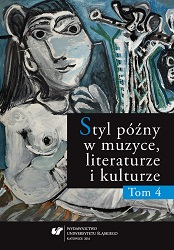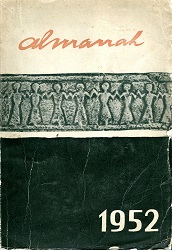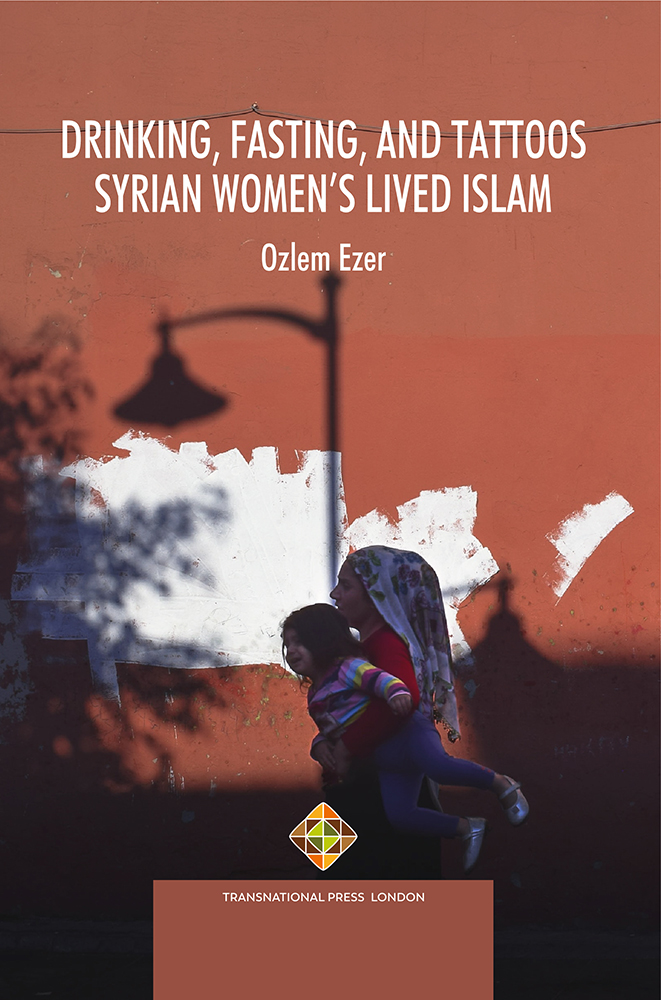
Библиография на проф. д.и.н. Елена Александрова Грозданожа. Непознатата Елена Грозданова
Full bibliography of the publications and studies by Prof. Grozdanova and texts of unknown poems written by her.
More...We kindly inform you that, as long as the subject affiliation of our 300.000+ articles is in progress, you might get unsufficient or no results on your third level or second level search. In this case, please broaden your search criteria.

Full bibliography of the publications and studies by Prof. Grozdanova and texts of unknown poems written by her.
More...
The late style is notoriously difficult to define, since for some creators, it correlates with the final period of their artistic activity, while for others, it begins much earlier. However, in both cases, it comes to signify artistic maturity and the mastering of a certain “grammar of creation,” discussed by George Steiner in his book. This philosopher and literary critic, who was also an expert on music, made numerous attempts at discussing “the dusk of the artistic endeavour” before arriving at the conclusion that what is crucial is the “cult of thebeginning,” the first notes of “the grammar of creation,” which function as an overture,marking the beginning of the work. It appears, then, that it is precisely in the “incipit” thatthe promise of the conclusion is located. The mature age can also manifest in the author’smastery of their artistic craft. The article includes numerous examples of fascinationwith the late style in poetry (William Shakespeare, John Donne, William Blake, ReinerMaria Rilke, James Joyce, Seamus Heaney, Gerard Manley Hopkins), as well as music andart (Roger Scruton, George Steiner, James Joyce). Zbigniew Herbert, Alfred Tennyson orWilliam Butler Yeats.
More...
The current report examines possibility of finding in the education, by applying educational innovations in the Judiciary. The time between 2014 – 2016, the district and regional court in Burgas were creating a pilot educational program, featuring schools from Burgas. They organize student practices, open door’s days. Subject of study will be the new ideas in the educational system, that implemented by two courts of law
More...
The article describes a common episode in the biography of the poet Jan Lechoń and the essayist and painter Józef Czapski. Representing the same generation, the artists did not take a liking to each other. Before World War II, their contacts were sporadic at best. In 1950, they met again in New York, which was Lechoń’s emigration residence. Czapski visited North America to raise money for the functioning of “Kultura” magazine in Paris. For this purpose, he was meeting with the Polish diaspora and giving lectures, in which he testified about the Katyń massacre. He included notes on the observed specificity of American culture in the quoted essays. For Lechoń, meetings with Czapski constituted a big mental and emotional problem, the evidence of which can be found in the poet’s Diary, kept regularly (at his doctor’s recommendation). After many years, reading that same diary helped.
More...
The article “American Disquiets of Jan Józef Szczepański” is an attempt to reconstruct the writer’s judgments and opinions on the changes that swept through the American culture in the late 1960s. The writer, diverging alone from the beaten tourist tracks, observes America; what testifies to it is his direct account of a diarist. When confronted with his subsequent literary texts, fragments of Szczepański’s Dzienniki [Diaries] reveal the often critical attitude of the writer towards the cultural and civilizational wonders of the United States.
More...
Polish reportages, in which the authors have tried to build an interesting and non-stereotypicalimage of the United States, are few. The reasons for this state of affairs seem complex. What discourages contemporary reporters from breaking the stereotypes is perhaps the fact that today the United States are the most exploited by mass culture place on Earth. Maybe the popular thinking that we already know everything there is to know about the US also still lingers. In 1997, Paweł Smoleński published Opowieści amerykańskie [American Tales], in 2009, Małgorzata Szejnert had her reportage Wyspa klucz [Key Island] released, and at the turn of the year 2013, reports by Katarzyna Surmiak-Domańska were printed in “Gazeta Wyborcza”. All three authors demonstrated a deep conviction that the United States is a country about which no generalizing judgments can be made since each opinion expressed about the country can be countered with one, equally corresponding to reality, that denies the previous. The reporters set an ambitious task for themselves — they want, at least in some measure, to understand the American society, its culture, tradition and way of thinking. That is why they talk to people and relate their stories, that is also why they focus their attention on unusual issues and phenomena, but primarily on the fate of individuals.
More...
The article contains an analysis of reportage books by Małgorzata Szejnert: Wyspa klucz [Key Island] and Borowiki przy ternpajku [Boletuses near the Turnpike]. The first book, illustrating the history of immigrant inspection station on Ellis Island in New York, is a starting point for discussion on Polish emigration to the United States at the turn of the 19th century. Anxieties of the then emigrants are juxtaposed with the portrait of contemporary Polish diaspora. The authoress discusses their current dilemmas and relationship with the past of their ancestors on the basis of the second of the above-mentioned books. What complements the problems discussed in the article are emigrational episodes in the biography of Szejnert herself as well as various American motifs present in the reporter’s other works.
More...
The research analysis in the article focuses on the volume titled Toronto, Tronto, Trana, co-authored by Jadwiga Jurkszus-Tomaszewska and Adam Tomaszewski, published in Canada in 1967. This book constitutes an interesting contribution to the understanding of the multicultural dimension of Canadian mentality. This book of reportage, in which the information is accompanied by insightful commentary and explanations, is analysed in the context of the genre of reportage written in Melchior Wańkowicz’s style, i.e. somewhere in between the news coverage, opinion journalism and — above all — literature. Toronto, Tronto, Trana can be called a tourist guidebook, a specific Baedeker’s Guide, containing descriptions that are not focused on the discussion of the co-authors’ emigrational fate, on the vision of their situation in the context of exile, of being an expatriate, an émigré, but rather on making use of the opportunities offered by the journey itself as well as demonstrating strong emotional ties with the new homeland – Canada, and especially with the city of permanent residence, namely Toronto.
More...
Based nearly exclusively on Tymon Terlecki’s home archive (letters, notebooks, press releases and other forgotten texts), the article is an attempt to reconstruct the literary evenings organized by the Polish Society of Academics in Chicago in 1964—1978, initiated by Terlecki. Thanks to the initiative and organizational effort of the Polish Society of Academics, the Polish community could meet various artists of multiple talents. During the inauguration of the academic year, writers and academics delivered speeches, among them: Danuta Mostwin and Florian Śmieja. Poetic evenings were held for Beata Obertyńska or Czesław Miłosz. From among the writers residing in America, the following presented their works during the literary evenings: Rόża Nowotarska, Bohdan Pawłowicz and Zbigniew Chałko, whereas Zofia Romanowiczowa came from Europe especially to participate. Among national artists presenting their literary works one could mention: Zbigniew Bieńkowski and Małgorzata Hillar, Jan Jόzef Szczepański, Artur Międzyrzecki and Julia Hartwig (winners of the scholarship offered by the University of Iowa) as well as Maria Dłuska and Tymoteusz Karpowicz. Special attention was given to theatre artists: Elżbieta Dziewońska-Krzemieńska, Mieczysława Ćwiklińska, Elżbieta Barszczewska and Łukasz Łukaszewicz. The successof these meetings was largely due to the active participation of the members of the Legionof Young Polish Women, the sponsors of the Chair of Polish Literature at the University of Chicago.
More...
The authoress of the article presents the figure of Adam Lizakowski, focusing on the poet’sinvolvement in the cultural life of the Polish community in San Francisco and Chicago. She discusses the activity of the poetic group Unpaid Rent as well as the cultural and literary initiatives they developed (individual and group poetic meetings, literary contests, writing workshops, meetings with actors, directors). She also presents the content of the quarterly “Dwa Końce Języka” as well as the social and cultural monthly “Razem.” Furthermore, she mentions a cycle of literary meetings organised in Golden Bookstore, the Polish bookstore owned by Lizakowski and the activity of the Lower Silesian Society in Chicago.The subject matter of the article is the editing activity and writing work of Adam Lizakowski.
More...
The article discusses Polish affairs in the US in the 1940s — one of the subject matters of anunknown journalistic cycle by Czesław Miłosz, published under the pseudonym of Jan M. Nowak in “Odrodzenie” from late 1946 through 1947. The content is made up of sociological observations collected during business as well as private trips, related to the post-war wandering and exile as well as the US immigration policy, comments on the place and role of the Polish community in American politics, remarks on the image of Poles in the West following the accusations of antisemitism, disputes with the journalists commenting on the course and outcome of the Parliamentary elections in 1947. The publicist’s commentaries are juxtaposed with the diagnoses formulated on diplomatic reports compiled by Miłosz for the Ministry of Foreign Affairs as part of his consular obligations, in order to highlight the mechanism of selecting issues and their interpretation.
More...
The text presents the American journalistic work of Leopold Tyrmand, published mainly in two magazines edited by him in the USA: “The Chronicles of Culture” and “The Rockford Papers.” Both were designed by Tyrmand as instruments supporting the combat against the so-called liberal culture, whose progressing expansion in the 1960s and 1970s was seen by the writer as the most serious threat to the western civilisation. A remedy for the decadence of the western world was to revive and promote the idea and values inherent in conservatism — the ideology fervently followed by Tyrmand in America. Blatant partiality and extremity of opinions expressed in the articles written by Tyrmand in that period have largely contributed to pushing this journalist work outside the mainstream of the public dispute in America.
More...
The author of the article poses a curious question before the literature of the second independence emigration — he asks about the world unpresented in this writing. He refers to the book by Julian Kornhauser and Adam Zagajewski, which gained fame in the early 1970s. In this text, the author enumerates specific “white spaces,” the aspects of American reality not presented in the literature of Polish emigrant writers. He offers a thesis that it was not always the propaganda fight in the ideologically divided world that was the reason why the writers failed to notice and observe particular aspects of life in the USA.
More...
The article attempts to identify the inspirations which G.R.R. Martin derives from the contemporary studies of prehistory. Unlike Tolkien, who was deeply indebted to German myths, Martin encapsulates yore in his work, stimulating the imagination of a reader in the 21st century with a power not weaker than that of any mythology. The predominant scienceinfluencing Martin in his creation of the quasi-Pleistocene of Westeros and Essos is palaeontology. Nevertheless, Martin equally well manages to revive the human culture of the actual prehistoric times. Consequently, he mostly draws upon the physical anthropology and archaeology. In order to depict the distant past of Westeros, Martin divides its times into threeperiods, resembling the traditional classification of prehistory into the Stone Age, the Bronze Age, and the Iron Age. The strategy adopted by Martin serves a twofold function; on the onehand, it allows him to oppose the rational world of Westeros to the lands beyond the Wall, tossed by magical forces, while on the other – it recalls the recent interest in the mysteries of prehistory embedded in popular culture, and by doing so it makes the universe of A Song of Ice and Fire familiar to readers.
More...
This paper aims at identifying the demythologising tendencies present in A Song of Ice and Fire. Moreover, it points to the discussion with the heroic myth, which in the case of the fantasy genre Martin contributes to happens to be bounded with the chivalry. The model of a picaresque novel is employed on account of the pseudo-medieval embedment of the depicted world and the wide exposition of the themes of the road. Speaking from the perspective of genre criticism, this generic form appears to be a response to the idealism emanating from the chivalric romances. When the picaresque – understood as a polemical means opposing to the classic fantasy works rooted in the mythological context (for instance, The Lord of the Rings) – is concerned, Arya Stark demands a greater attention. The strategy adopted by Martin corresponds to Bogdan Trocha’s thesis concerning the degradation of a myth in fantasy literature. Simultaneously, it is one of the numerous tendencies popular among the contemporary texts of culture, dismantling the generic indicators and playing with literary conventions.
More...

The relationship between firms and stakeholders is held together by a continuous two-way cycle of value creation. In this, how can value be managed such that the stakeholder’s wellbeing is ensured? How does stakeholder wellbeing vary across business contexts? Are there varied perspectives in understanding stakeholder wellbeing? These and other pertinent questions have been addressed in this book.Particularly, this book provides a synthesis of research perspectives on value creation and stakeholder wellbeing through a collection of chapters from scholars in this area. It synthesizes research perspectives on value into three categories – firm-focused, customer-focused, and community-focused. In doing so, this book presents novel insights through these lenses and highlights best practices in ensuring stakeholder wellbeing.Responding to the rapidly changing business landscape where stakeholders are more connected, accessible, and informed than ever before, many firms are interested in creating value for all and in the process ensuring stakeholder wellbeing. This book will appeal to research scholars, practitioners, consultants, and managers looking to seek new insights and understanding on value creation.
More...
Turkish science fiction dates back to the early years of the twentieth century and serious development has been seen ever since. The writers, who escaped from the darkness of the First World War and took refuge in utopian science fiction, added the excitement created by science and technology to their texts over time. Turkish writers, who followed the science fiction works from the West and made efforts for the development of this genre, produced very qualified works that could compete with their contemporaries at some points. However, due to some historical, social, and economic problems, it was not possible for these works to meet readers in the West. In this anthology, the works of Turkish science fiction writers are brought together for the first time in English. Contemporary science fiction writers have written short stories for this anthology. Hence, the resulting diversity of stories represents a contribution to science fiction literature. An important feature of the anthology is that it includes examples showing how science and technology are perceived philosophically by authors outside of Europe and America. Since literature is an indispensable resource to investigate the equivalent of science fiction, which was born with modernism, in “post-modern” societies. This anthology of Turkish science fiction will be an important Non-Western SF source for both science fiction readers and researchers.
More...
The text deals with life in the 1930s and 1940s in the area of today's western and northern Bohemia, southern Poland and northern Moravia, based on the autobiographical prose of Ota Filip and Horst Bienko. The texts of these authors refer mainly to northern Moravia and the historical region of Upper Silesia. The memoirs of other authors - Frank Sikora, Eva Althammer-Švorčíková, Hubert Sigmund and Gerold Tietz - deal with life in western and northern Bohemia. In addition to the texts of these authors, the writings of other memoirists (oral history), publicists (contemporary and contemporary texts) and historians (monographs, historiographical studies) are also taken into account.
More...
This groundbreaking edited book offers an innovative lens to explore how migration and social change are intertwined, moving beyond sensationalized media narratives and political agendas. It introduces the concept of “migratory stratification,” challenging researchers to focus on the long-lasting effects of migration rather than fleeting, superficial headlines. By investigating immigrant labour dynamics, migration policies, and socio-historical contexts, the book delves into the structural forces that shape migration and the working-class struggles that emerge. Featuring in-depth case studies from Italy, it reveals migration’s deep social impact on labour, politics, and urban spaces, providing fresh insights into contemporary migration studies.Ideal for academics, policymakers, and readers interested in a nuanced, long-term view of migration, Migratory Stratifications sheds light on the stratification processes that influence both immigrants and the societies they reshape.
More...